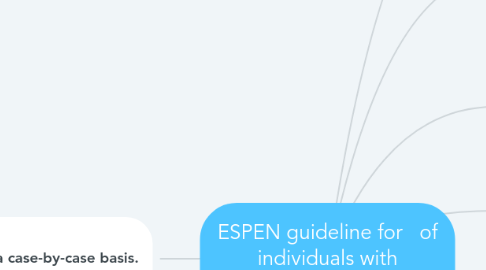ESPEN guideline for of individuals with COVID-19
by Emtenan Elsayed

1. Statement 1 Patients at risk for poor outcomes and higher mortality following infection with SARS-COV-2, namely older adults and poly-morbid individuals, should be checked for malnutrition through screening and assessment.
2. Statement 2 Subjects with malnutrition should try to optimize their nutritional status, ideally by diet counseling from an experienced professionals (registered dieticians, experienced nutritional scientists, clinical nutritionists and specialized physicians).
3. Statement 3 Subjects with malnutrition should ensure sufficient supplementation with vitamins and minerals.
4. Statement 4 • Patientsinquarantineshouldcontinueregularphysicalactivitywhiletakingprecautions: • Reducing infectious risk is achieved best by quarantine at home, which is heavily recommended presently for all people at risk of COVID-19 and also for those infected with a rather moderate disease course. • However, prolonged home stay may lead to increased sedentary behaviors, such as spending excessive amounts of time sitting, reclining, or lying down for screening activities (playing games, watching television, using mobile devices); reducing regular physical activity and hence lower energy expenditure. • Thus quarantine can lead to an increased risk for and potential worsening of chronic health conditions, weight gain, loss of skeletal muscle mass and strength and possibly also loss of immune competence since several studies have reported positive impact of aerobic exercise activities on immune function.
5. Statement 5 • Oral nutritional supplements (ONS) should be used whenever possible to meet patient’s needs, when dietary counseling and food fortification are not sufficient to increase dietary intake and reach nutritional goals, ONS shall provide at least 400 kcal/day including 30 g or more of protein/day and shall be continued for at least one month. • Efficacy and expected benefit of ONS shall be assessed once a month.
6. Statement 6 • In poly-morbid medical inpatients and in older persons with reasonable prognosis, whose nutritional requirements cannot be met orally, enteral nutrition (EN) should be administered. • Parenteral nutrition (PN) should be considered when EN is not indicated or unable to reach targets.
7. Statement 7 • In COVID-19 non-intubated ICU patients not reaching the energy target with an oral diet, oral nutritional supplements (ONS) should be considered first and then enteral nutrition treatment. • If there are limitations for the enteral route it could be advised to prescribe peripheral parenteral nutrition in the population not reaching energy-protein target by oral or enteral nutrition.
8. Statement 8 • In COVID-19 intubated and ventilated ICU patients enteral nutrition (EN) should be started through a nasogastric tube; post-pyloric feeding should be performed in patients with gastric intolerance after prokinetic treatment or in patients at high-risk for aspiration
9. Statement 9 • In ICU patients who do not tolerate full dose enteral nutrition (EN) during the first week in the ICU, initiating parenteral nutrition (PN) should be weighed on a case-by-case basis. • PN should not be started until all strategies to maximize EN tolerance have been attempted.
10. Statement 10 • In ICU patients with dysphagia, texture-adapted food can be considered after extubation (the removal of an endotracheal tube, which is the last step in liberating a patient from the mechanical ventilator) . If swallowing is proven unsafe, EN should be administered. In cases with a very high aspiration risk, postpyloric EN or, if not possible, temporary PN can be performed.


